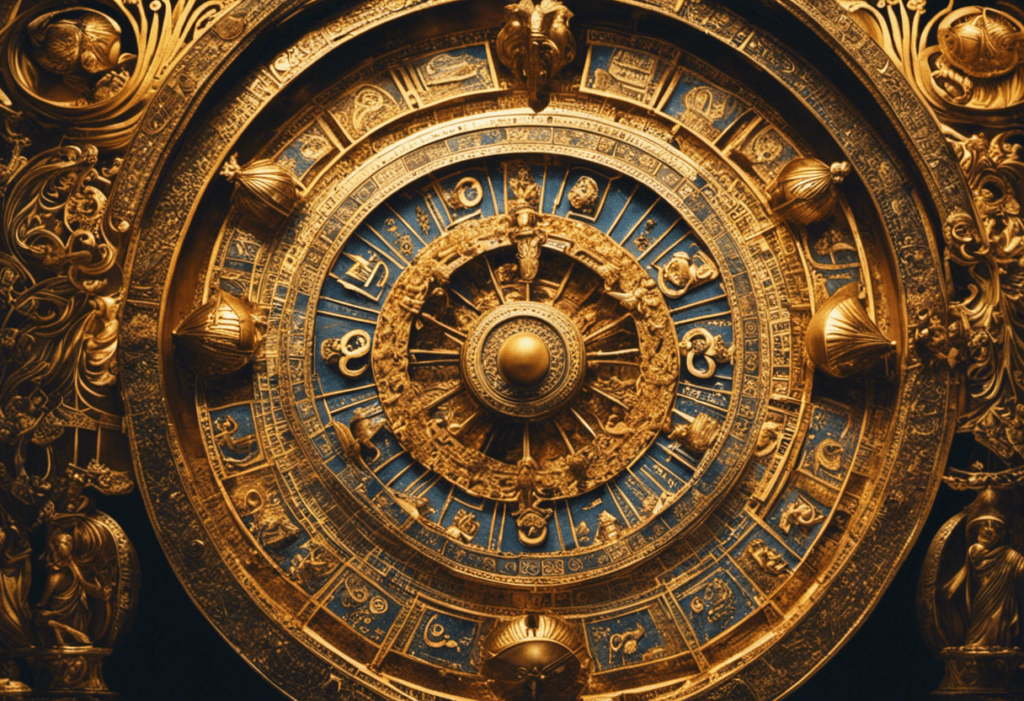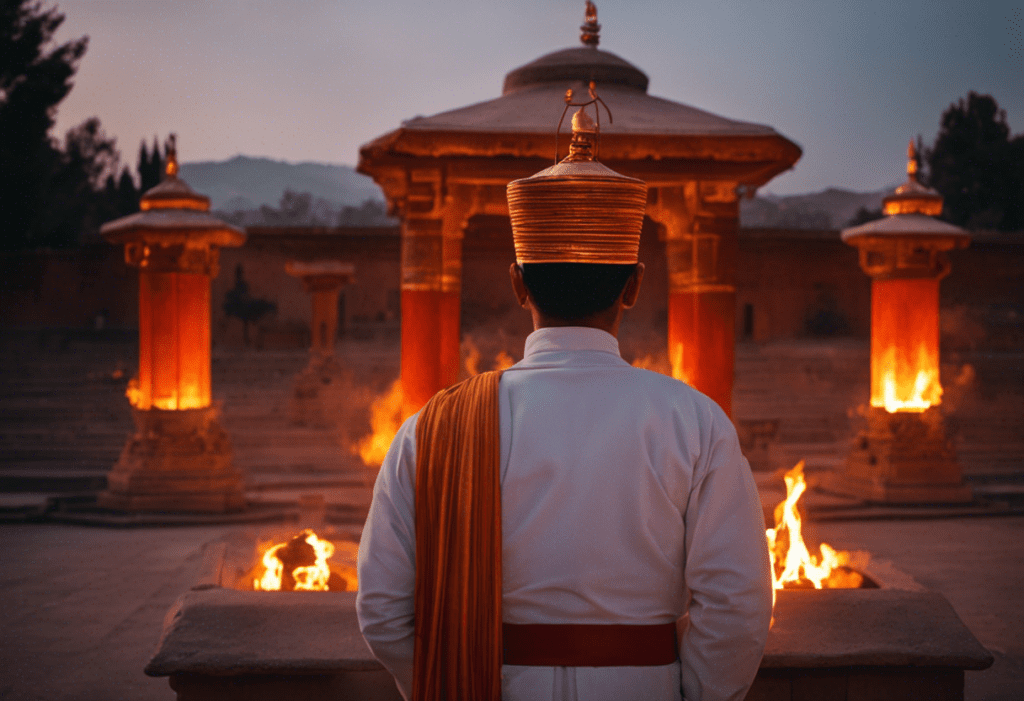As the winter fades away and the first rays of spring bathe the world in warmth, the Zoroastrian community eagerly awaits the dawn of a new year – Nowruz. This ancient festival, deeply rooted in symbolism and traditions, holds immense significance for followers of Zoroastrianism.
From the lighting of sacred fires to the feasting on traditional delicacies, Nowruz is a time for renewal, gratitude, and the celebration of life.
Join us as we delve into the rich tapestry of Nowruz and explore its timeless allure.
Key Takeaways
- Nowruz is a holiday celebrated by many Iranians and other communities around the world.
- Nowruz originated in ancient Persia and has been celebrated for over 3,000 years.
- The holiday marks the beginning of spring and is observed on the day of the vernal equinox.
- Symbolism and traditions of Nowruz include the Haft Seen table, spring cleaning, jumping over bonfires, vibrant decorations, and traditional dishes.
The Origins of Nowruz
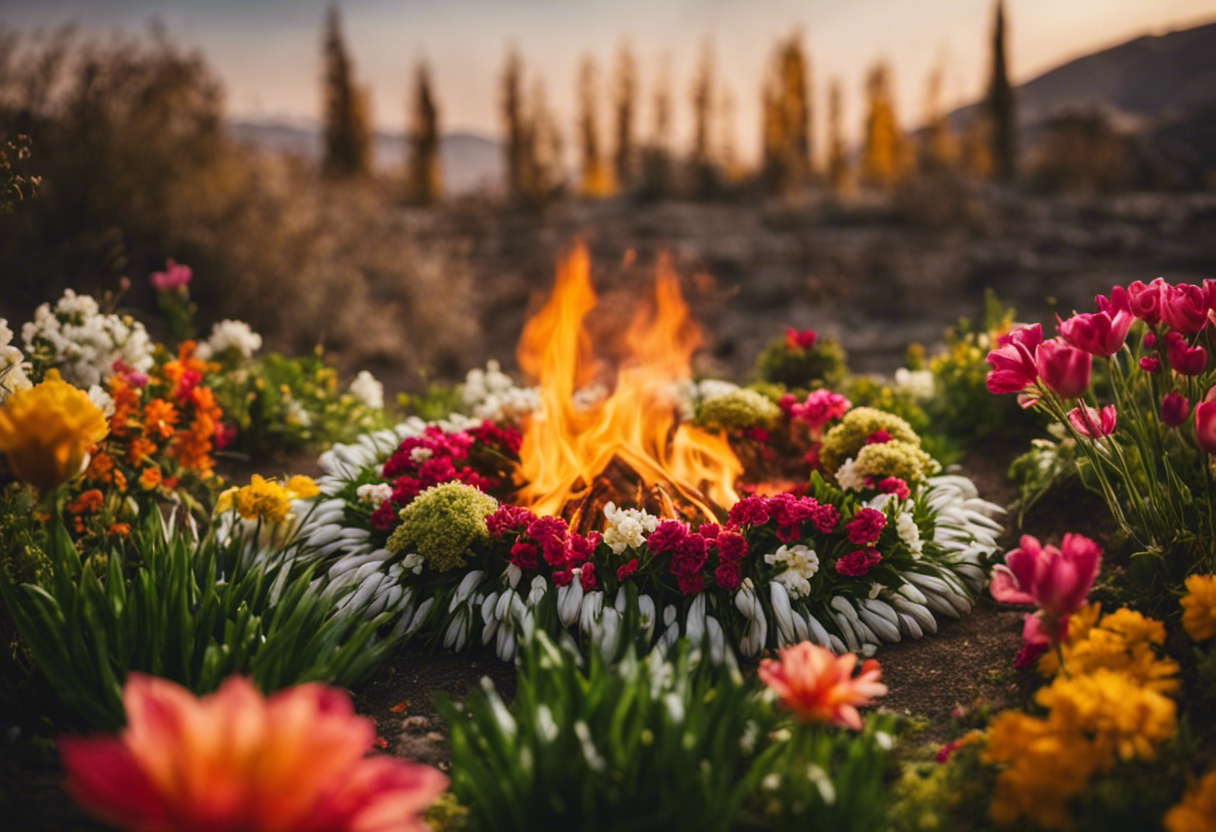

The origins of Nowruz, a holiday celebrated by many Iranians and other communities around the world, can be traced back to ancient Zoroastrian traditions. Nowruz, which means ‘new day’ in Persian, marks the beginning of spring and the rejuvenation of nature. It has a long history that dates back more than 3,000 years.
Nowruz originated in ancient Persia, the birthplace of Zoroastrianism, one of the world’s oldest religions. Zoroastrianism was founded by the prophet Zoroaster, who lived in the 6th century BCE. The festival of Nowruz was an integral part of Zoroastrian beliefs and practices, symbolizing the triumph of light over darkness and the renewal of life.
The exact origins of Nowruz are not well-documented, but it is believed to have been celebrated by the ancient Persians as a way to honor the sun god, Mithra, and to herald the arrival of spring. Over time, Nowruz became more than just a religious festival and evolved into a cultural celebration that marked the beginning of the Persian calendar year.
Today, Nowruz is celebrated by millions of people around the world, particularly in Iran, Afghanistan, Tajikistan, and other countries with Persian and Zoroastrian heritage. It is a time of joy and renewal, with customs and traditions that include spring cleaning, family gatherings, the setting of a Haft-Seen table, and the exchange of gifts. Nowruz continues to be a cherished holiday, deeply rooted in the history and culture of the Persian people.
The Symbolism of Nowruz
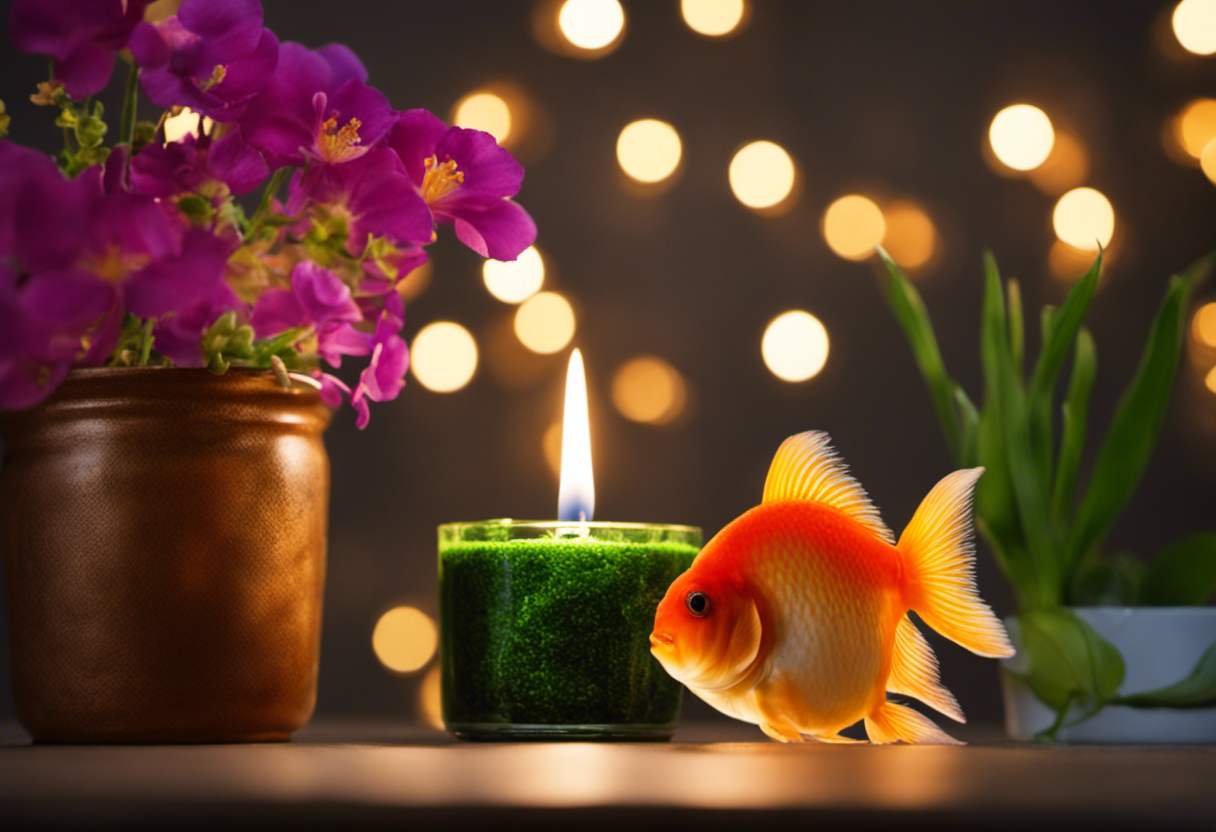

One of the significant aspects of Nowruz is its symbolism, which includes various customs and rituals that represent the concept of renewal and the hope for a prosperous year ahead. Nowruz, which means ‘New Day’ in Persian, is celebrated by millions of people worldwide, particularly in Iran and Central Asia. The symbolism embedded in Nowruz reflects its cultural significance and serves as a reminder of the values and aspirations of the communities that observe it.
One of the most prominent symbols of Nowruz is the Haft Seen, a traditional table setting that includes seven symbolic items starting with the Persian letter ‘seen.’ These items, such as Sabzeh (sprouted wheat or lentil) and Senjed (dried Persian olive), represent different aspects of life and nature. The act of setting up the Haft Seen is seen as a way of inviting positive energy and abundance into the household.
Another important custom is the practice of spring cleaning, known as ‘Khouneh Tekouni.’ This act of cleaning not only ensures a clean and fresh environment but also symbolizes the cleansing of the soul and the elimination of negativity from one’s life. It is believed to bring good luck and prosperity for the upcoming year.
In addition to these customs, Nowruz is marked by various other symbolic rituals, such as jumping over bonfires to symbolize the purification of the soul and the renewal of life. These traditions highlight the cultural significance of Nowruz as a time of spiritual rejuvenation and hope for a prosperous year ahead.
Nowruz Traditions and Customs
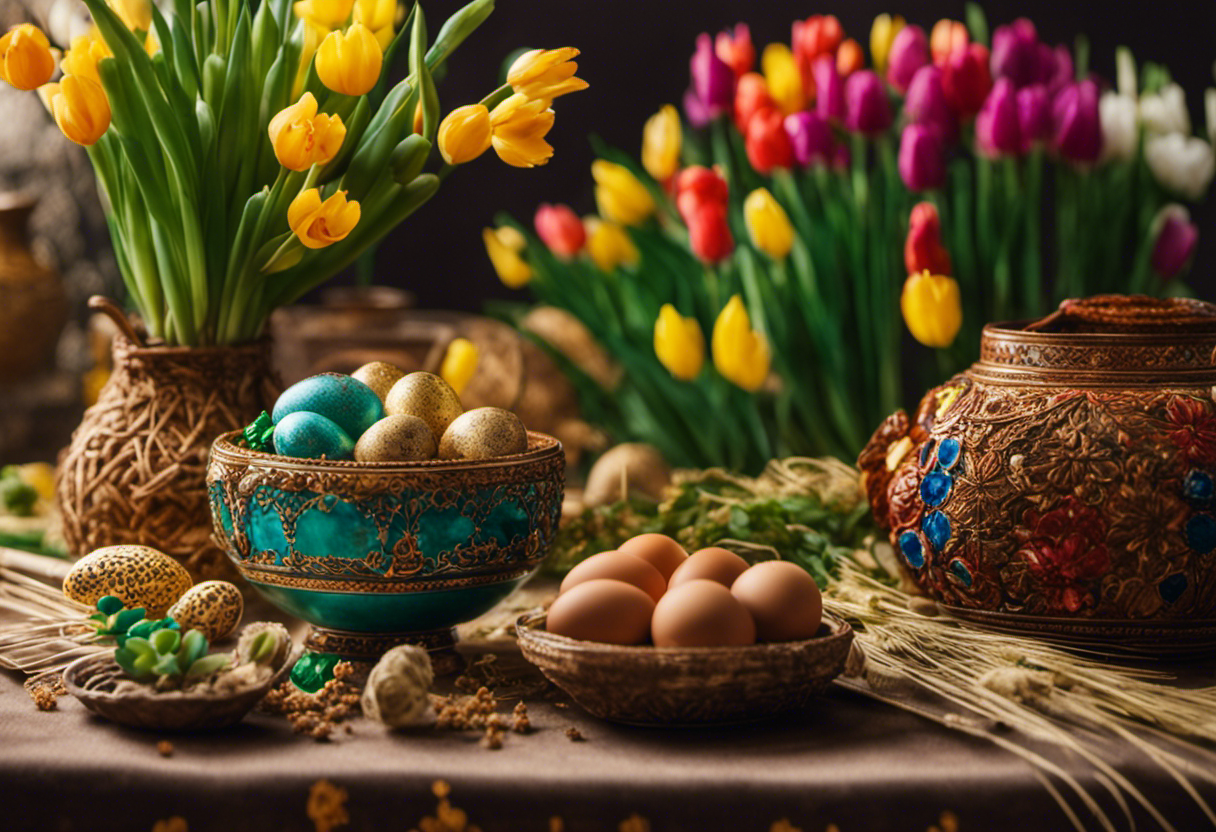

Nowruz festivities encompass a variety of customs and traditions, embodying the essence of renewal and fostering a sense of unity among communities. One of the key elements of Nowruz celebrations is the vibrant and colorful decorations that adorn homes and public spaces. These decorations symbolize the arrival of spring and the renewal of life. Flowers, particularly hyacinths and tulips, are commonly used in Nowruz decorations, as they represent beauty and rebirth. Additionally, colorful ribbons, called ‘sabzeh,’ are hung to symbolize growth and prosperity.
Nowruz music also plays a significant role in the celebrations. Traditional songs and melodies are performed to create a joyful and festive atmosphere. These songs often reflect themes of love, nature, and the arrival of spring. Instruments such as the daf (a large frame drum) and the tar (a stringed instrument) are commonly used in Nowruz music to create rhythmic and melodious tunes.
Furthermore, Nowruz celebrations involve various customs that are passed down through generations. These customs include the preparation of traditional dishes, such as sabzi polo (herbed rice) and ash-e reshteh (a thick noodle soup), as well as the gathering of family and friends for festive meals. The exchange of gifts and the practice of visiting elders and relatives are also common customs during Nowruz.
Overall, Nowruz traditions and customs, including the vibrant decorations and lively music, contribute to the festive and joyful atmosphere of this important celebration.
The Role of Fire in Nowruz Celebrations


Fire plays a significant role in Nowruz celebrations, symbolizing purification and renewal. Symbolic fire rituals are an integral part of the festivities, with people jumping over flames to cleanse themselves of negativity and start the new year afresh.
Lighting the ceremonial fire is a momentous event, bringing communities together to celebrate the power of fire and its role in the spiritual and cultural traditions of Nowruz.
Symbolic Fire Rituals
How do these symbolic fire rituals contribute to the overall symbolism and meaning of Nowruz celebrations?
The symbolic fire rituals in Nowruz celebrations hold great significance and contribute to the overall symbolism and meaning of the festival in several ways:
-
Fire Symbolism:
- Fire is seen as a symbol of purity, enlightenment, and divine power in Zoroastrianism.
- The fire rituals represent the eternal light of wisdom and truth that Zoroastrians seek to bring into their lives.
-
Spiritual Purification:
- The act of jumping over the bonfire during the Chaharshanbe Suri ritual is believed to cleanse individuals of their sins and impurities.
- It symbolizes the renewal of the soul and the beginning of a fresh start in the new year.
These symbolic fire rituals not only reinforce the cultural and religious significance of Nowruz but also provide a profound spiritual experience for participants, fostering a sense of unity and hope for the year ahead.
Purification Through Flames
During the purification rituals of Nowruz celebrations, participants engage in a transformative experience by immersing themselves in the intense heat and radiant glow of the flames. Flame purification is a significant aspect of the Nowruz tradition, symbolizing spiritual cleansing and renewal.
This ancient Zoroastrian practice holds deep symbolic meaning, representing the transformation of darkness into light and the purging of negative energies. The flames are believed to possess spiritual power, capable of purifying the mind, body, and soul.
Participants stand before the fire, offering prayers and intentions, allowing the heat and energy of the flames to cleanse them of impurities and negativity, and rejuvenate their spirit. Through this ritual, individuals seek to purify themselves, release past burdens, and start anew, embracing the coming year with a renewed sense of hope and positivity.
Lighting the Ceremonial Fire
The flickering glow of the ceremonial flames illuminates the faces of participants as they gather around, symbolizing the beginning of the Nowruz celebrations. The lighting of the ceremonial fire holds great significance in Zoroastrianism, the ancient religion of Persia.
Here are two sub-lists that highlight the importance and symbolism of fire in this tradition:
-
Significance of the Ceremonial Fire:
- Represents purity and spiritual transformation.
- Believed to ward off evil spirits and bring blessings for the coming year.
-
Fire Symbolism in Zoroastrianism:
- Fire is considered a symbol of divine energy and wisdom.
- Represents the presence of Ahura Mazda, the supreme deity in Zoroastrianism.
The ceremonial fire plays a central role in Nowruz celebrations, serving as a visual representation of the spiritual essence and renewal that accompanies the start of a new year. Its warm glow and dancing flames create an atmosphere of reverence and hope, setting the stage for a joyous and prosperous year ahead.
Nowruz Rituals and Ceremonies
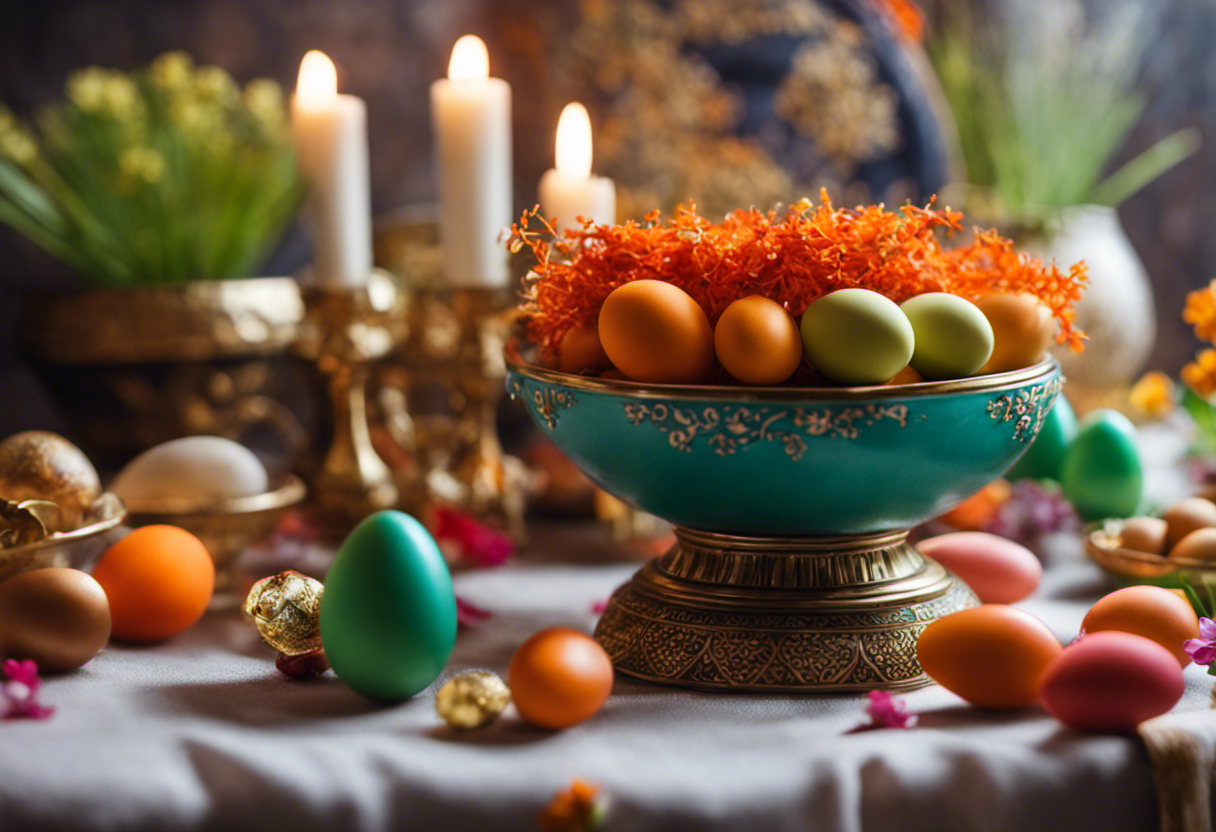

Families joyfully gather annually to participate in the traditional Nowruz rituals and ceremonies, faithfully observing the ancient customs passed down through generations. Nowruz, also known as the Zoroastrian New Year, is celebrated by millions of people worldwide, especially in Iran and Central Asia.
One of the central elements of Nowruz celebrations is music, which plays a vital role in creating an atmosphere of joy and happiness. Nowruz music is characterized by its lively and rhythmic melodies, often accompanied by traditional instruments such as the tambourine, flute, and drum. These musical performances are an integral part of the festivities and bring people together in a spirit of unity and celebration.
In addition to music, Nowruz decorations also play a significant role in creating a festive ambiance. Houses and streets are adorned with colorful and vibrant ornamentations, symbolizing renewal and abundance. One of the most commonly used decorations is the Haft Seen table, which is set up with seven symbolic items starting with the Persian letter ‘seen.’ These items include sprouted wheat or lentils representing rebirth, apples symbolizing beauty and health, and a mirror symbolizing reflection and self-reflection. Other traditional decorations include flowers, candles, and painted eggs, which are all meant to bring good luck and prosperity for the coming year.
Overall, Nowruz rituals and ceremonies are a time of joy and celebration, filled with music and vibrant decorations. These traditions connect families and communities, fostering a sense of unity and hope for the year ahead.
Nowruz Food and Feast


Nowruz, the Zoroastrian New Year, is celebrated with a variety of traditional dishes and a lavish feast. These culinary delights hold great significance and are prepared with meticulous care.
From sabzi polo to ash reshteh, each dish carries its own symbolic meaning, contributing to the overall festive atmosphere of Nowruz.
Traditional Nowruz Dishes
Celebrating the arrival of spring, Iranians joyfully partake in savoring the mouthwatering flavors of delectable dishes traditionally prepared during Nowruz. This ancient Persian festival, marking the beginning of a new year, is a time for families to come together and indulge in various traditional recipes. The festive decorations and vibrant atmosphere add to the joyous spirit of the occasion.
Here are two sub-lists to entice your taste buds and pique your interest in these traditional Nowruz dishes:
-
Sabzi Polo Mahi:
- A fragrant rice dish cooked with fresh herbs such as parsley, dill, and coriander.
- Served alongside grilled or fried fish, symbolizing good luck and abundance for the year ahead.
-
Ash Reshteh:
- A hearty soup made with herbs, legumes, and noodles.
- Often garnished with fried onions, whey, and mint, this dish is believed to bring prosperity and good fortune.
Indulge in the culinary delights of Nowruz and experience the rich flavors that have been passed down through generations.
Symbolic Food Preparations
The inclusion of symbolic food preparations in Nowruz feasts highlights the cultural significance and spiritual beliefs of Iranians during this auspicious time of the year. Nowruz, also known as the Zoroastrian New Year, is celebrated on the spring equinox and holds great importance in Iranian culture.
Traditional food preparations play a crucial role in the festivities, as they symbolize various aspects of life, renewal, and prosperity. One such example is the Haft-Seen table, where seven items starting with the Persian letter ‘S’ are displayed, each representing a wish or hope for the upcoming year. Sabzeh (sprouts) symbolizes rebirth, samanu (sweet pudding) represents affluence, and senjed (dried fruit of the lotus tree) signifies love.
These symbolic food meanings not only enhance the visual appeal of the Nowruz feasts but also serve as a reminder of the deep-rooted traditions and beliefs held by Iranians.
Feast Traditions and Customs
During Nowruz feasts, various delicious dishes are prepared, showcasing the rich diversity and customs of Iranian cuisine. The feast preparations for Nowruz are a significant part of the celebration, as they symbolize the abundance and prosperity that the new year will bring. Festive decorations adorn the tables, creating a vibrant and joyful atmosphere.
Here are some highlights of the feast traditions and customs observed during Nowruz:
-
Traditional dishes: A variety of dishes are prepared, including sabzi polo ba mahi (herb rice with fish), dolmeh (stuffed vegetables), and ash reshteh (noodle soup). Each region in Iran has its own specialties, adding to the culinary diversity.
-
Haft-Seen table: This is a central element of the feast, featuring a spread of symbolic items representing different aspects of life, such as rebirth, wealth, and health. This table is beautifully decorated with flowers, candles, and other festive ornaments.
The feast traditions and customs of Nowruz not only satisfy the taste buds but also create a sense of unity and joy among Iranians celebrating the arrival of a new year.
Nowruz Around the World
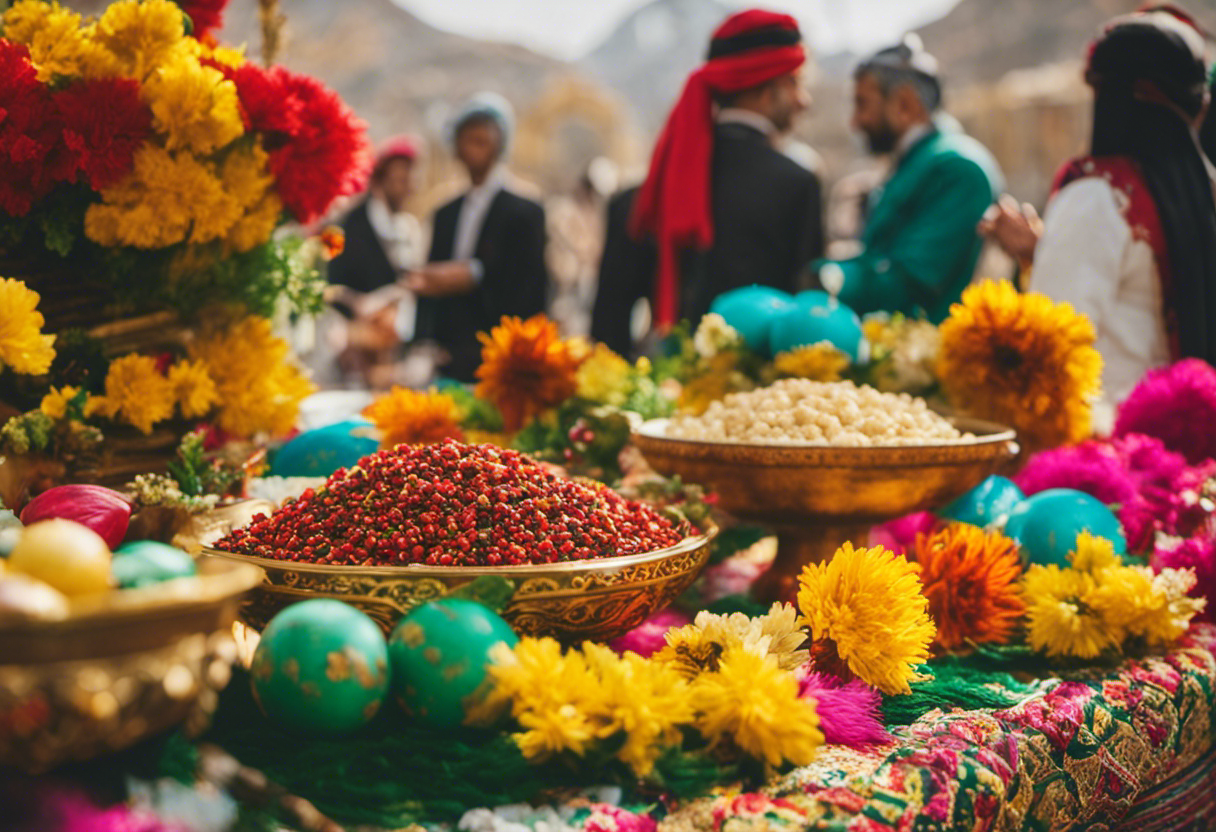

An annual cultural festival, Nowruz is widely observed around the world by diverse communities. Nowruz, meaning ‘New Day’ in Persian, marks the beginning of spring and the Persian New Year. It is celebrated on the day of the vernal equinox, usually falling on March 21st. Nowruz has its roots in ancient Persia and has been celebrated for over 3,000 years. Today, it is observed by millions of people of different ethnic and religious backgrounds, including Iranians, Afghans, Azerbaijanis, Kurds, and Tajiks, among others.
Nowruz festivities typically last for two weeks and involve various customs and traditions. The preparations for Nowruz start weeks in advance, with people cleaning their homes, buying new clothes, and gathering ingredients for special dishes. On the eve of Nowruz, families gather around the Haft-Seen table, which is beautifully decorated with seven symbolic items representing renewal, prosperity, and happiness. These items often include wheat sprouts, coins, a mirror, and colored eggs.
During Nowruz, people visit family and friends, exchange gifts, and participate in public celebrations. Street performances, concerts, and traditional dances are common during this time. Nowruz is not only a time of celebration but also a time for reflection, forgiveness, and unity. It is a festival that brings people together to embrace the arrival of spring and the hope for a prosperous year ahead.
Conclusion
In conclusion, Nowruz, the Zoroastrian New Year, is a vibrant celebration that holds deep cultural and historical significance. Its origins date back to ancient times, and its symbolism reflects the cycle of life, renewal, and the triumph of light over darkness.
The rituals and traditions associated with Nowruz are diverse and varied, with fire playing a central role in the festivities. The feast and food shared during this time bring communities together in joy and gratitude.
Nowruz is celebrated around the world, showcasing the global reach of this ancient tradition.


